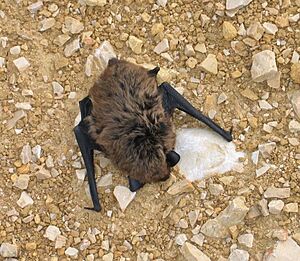Savi's pipistrelle facts for kids
Quick facts for kids Savi's pipistrelle |
|
|---|---|
 |
|
| Conservation status | |
| Scientific classification | |
| Genus: |
Hypsugo
|
| Species: |
savii
|
Savi's pipistrelle, also known as Hypsugo savii, is a small type of bat that lives in parts of Africa, Europe, and the Middle East. These bats are active at night, hunting flying insects for food. During warmer months, they sleep in places like under tree bark, in tree holes, old buildings, or cracks in rocks. When it gets colder, they look for warmer spots like caves or deep rock cracks to stay cozy.
About Savi's Pipistrelle
Savi's pipistrelle is a small bat. Its head and body are about 1.75 to 2 inches (44 to 51 mm) long. Its forearm, from elbow to wrist, is about 1.25 to 1.5 inches (32 to 38 mm) long. This bat usually weighs between 0.26 and 0.35 ounces (7.4 and 9.9 g).
It has wide, round ears. Each ear has a short, rounded part called a tragus. The bat's face, ears, and wing membranes are black. The fur on its back is dark brown. The fur on its belly is pale. This makes a clear difference between its back and its chest. Savi's pipistrelle has a tail that is longer than other bats like it.
Where They Live
Savi's pipistrelle lives in many places. You can find them in southern Europe, North West Africa, and the Middle East. They also live in central Asia, Mongolia, and northern Japan. They have been seen in the Canary Islands, Switzerland, and Austria.
These bats mostly live in mountains. They can be found at heights up to 2,500 metres (8,200 ft). They like bushy hills with trees and rocky areas. They also like cliffs, deep valleys, and old ruins.
During summer days, they hide in many spots. They might be under tree bark or in rock cracks. They also use hollow trees, holes in walls, or under roofs of buildings. In winter, they find safer places to sleep. They often go into caves or deep rock cracks. They usually sleep alone in these spots.
What They Eat and How They Live
Savi's pipistrelle eats flying insects. It catches them while flying. It uses a special skill called echolocation to find its food. This means they send out sounds that humans cannot hear. These sounds bounce off objects, helping the bat know where things are. They even time their sounds with their wing beats. This helps them find insects from far away.
These bats drink water by flying low over it. They raise their wings and scoop up water with their tongue. They might hunt for food over grassy fields, in villages, or near streetlights.
Savi's pipistrelle has its babies in the summer. Up to 70 female bats might gather together. They form groups called "maternity communities." This is where they raise their young.
Protection Status
Savi's pipistrelle is listed as "Least Concern" by the IUCN Red List of Threatened Species. This means their population is stable. There are no big threats that hurt them right now.
Many countries protect all their bats. Savi's pipistrelle is also protected by the Bonn Convention (Eurobats). This is an agreement that many countries have signed. In Europe, it is also protected by the EU Habitats and Species Directive.


